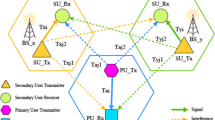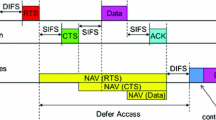Abstract
There is a growing demand for bandwidth as well as mobility. Within ETSI BRAN a wireless LAN called HIPERLAN/2 has been standardized. While data rates can be as high as 54 Mbit/s for a high carrier to interferer ratio (C/I), more robust combinations of modulation and code-rate have to be used and also retransmissions do occur when interference is present. This leads to much smaller effective data rates. Interference and link adaptation are therefore important topics. In order to have a realistic co-channel interference, two radio cells are implemented which interact with each other. In both radio cells detailed implementations of the protocols are used. Data transmission between the terminals is carried out via TCP/IP, respectively UDP. In this paper it is shown how throughput as well as delay can be improved in all load conditions by reducing co-channel interference and reducing the variations in the interference situation which significantly increases the effectiveness of link adaptation.
Similar content being viewed by others
References
S. Deng, Empirical model of WWW document arrivals at access link, in: Internat. Communications Conference (ICC), 1996.
ETSI BRAN, HIPERLAN type 2 technical specification TS 101 475 V1.1.1, Physical (PHY) layer (April 2000).
ETSI BRAN, HIPERLAN type 2 technical specification TS 101 761-1 V1.1.1, Data Link Control (DLC) layer, Part 1 - Basic data transport function (April 2000).
M. Fiacco, S. Stavrou and S.R. Saunders, Measurement and modelling of shadowing cross-correlation at 2 Ghz and 5 Ghz in indoor environments, in: Antennas and Propagation 2000, Davos, Switzerland, 9-14 April 2000.
M. Gudmundson, Correlation model for shadow fading in mobile radio system, Electronics Lett. 27 (November 1991) 2145-2146.
J. Khun-Jush, P. Schramm, U. Wachsmann and F. Wenger, Structure and performance of the HIPER-LAN/ 2 physical layer, in: Proc. of IEEE VTC'99, Amsterdam, 1999.
J. Rapp, HIPERLAN/2 system throughput and QOS with interference improving strategies, in: Proc. of IEEE VTC'01, Spring, RI, 2001.
Author information
Authors and Affiliations
Rights and permissions
About this article
Cite this article
Rapp, J. Increasing Throughput and QoS in a HIPERLAN/2 System with Co-channel Interference. Telecommunication Systems 19, 289–299 (2002). https://doi.org/10.1023/A:1013873904083
Issue Date:
DOI: https://doi.org/10.1023/A:1013873904083




